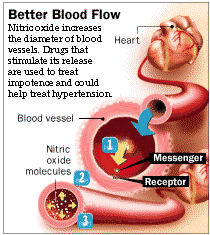The Biological Action of Sildenafil Citrate(Viagra™)
The mechanism:
|
Biological systems rely on a complex set of primary and secondary messengers in order to regulate activity. In the reproductive system nitrous oxide, NO, is released locally from nerve endings in the endothelial cells of the erectile tissue(corpus carvenosum), when stimulated. Nitrous oxide is made with the aide of the enzyme NO synthase, which deaminates the amino acid L-arginine(Fig 1.),thus producing NO and citrulline. |
|

Fig 1. N0 mediated cGMP production
|
|
The NO then diffuses out of the cell in which it was synthesised, and into neighbouring cells. NO then acts with iron in the enzyme guanylyl cyclase to produce the intracellular mediator(second messenger) guanosine monophosphate (3':5'cyclic GMP,Fig1) from guanosine triphosphate (GTP). This molecule cGMP is the vital component of the system. It acts as a vasodilator by relaxing smooth muscle in the blood vessels of the corpus cavernosum (see Fig 2.) |
|
Fig 2. The biological mechanism of sildenafil citrate

|
This leads to increased blood flow into the penis and hence an erection. In order to mediate this process a phosphodiesterase enzyme, PDE-5 hydrolyses the cGMP to an inactive form, GMP In healthy male this acts as a vital regulatory system. However, men suffering from erectile dysfunction (ED) may produce insufficient NO and hence insufficient amounts of cGMP, which are of course broken down by the PDE-5 enzyme to achieve an erection. Sildenafil Citrate binds with the active site of |
the PDE enzyme, thus preventing it from hydrolysing cGMP. This allows the produced cGMP to remain in its active form for longer and hence have a larger vasodilatory effect. Hence it does not cause an increase in the amount of vasodialator produced, but rather allows longer use of that which is.
PDE receptors
The are nine different types of PDE receptor, found in different tissues of the body. However, the PDE-5 receptors are principally found in male erctile tissue and not in other parts of the body which explains the inactivity of sildenafil citrate as an antianginal drug(as coronary tissues use principally the pde-3 type receptors),see Discovery. PDE-5 receptors are also found in platelets and various muscle tissues(Vascular, skeletal and visceral). The inhibition of these receptors by sildenafil helps to explain peripheral arterial venous dilation, inhibition of platelet thrombus, other side effects related to the PDE receptors include visionary distortion.(see Side effects), as PDE-6 receptors are found in the retina. Sildenafil has an affinity for this type of receptor, which is about 10 times smaller than that for PDE-5. Due to its mechanism of action sildenafil citrate will work on ED regardless of the cause as long as it involves lower levels of NO. However it is important to note that Viagra lengthens the life of cGMP, but does not directly produce it, hence cannot act as any sort of aphrodisiac
Removal of Sildenafil from the body
Sildenafil is broken down in the liver by hepatic metabolism using cytochrome p450 enzymes, mainly CYP450 3A4(major route),but also by CYP2C9(minor route) hepatic isoenzymes. The major product of metabolisation by these enzymes is N-desmethylated sildenafil, which is metabolised further. This metabolite has in itself has an affinity for the PDE receptors, about 40% of that of sildenafil. The metabolite is thus responsible for about 20% of sildenafils action.
More information:

